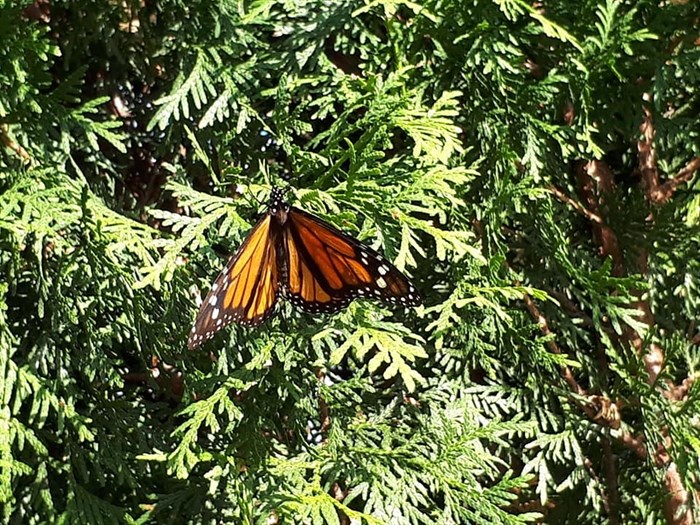
A monarch butterfly spotted in Kelowna's Rutland neighbourhood, July 6, 2022.
Image Credit: SUBMITTED/Jasmine Korcok
July 08, 2022 - 7:30 AM
A Kelowna resident and her mother were surprised and excited to find a beautiful orange monarch butterfly while on a walk in the city.
Jasmine Korcok and her mother were walking, July 6, on a road they don’t normally travel on when they saw the butterfly in the middle of the road. It flew into the air and landed in a cedar hedge.
She’s lived in Kelowna for 10 years but has never seen one in the Okanagan before.
“I’m from Ontario though so I’m quite familiar with them… I was so excited,” she said.
She took a few photos on Morrison Road before they went on their way.
Monarchs are occasionally seen in the province, but not often, said Thompson Rivers University entomologist Rob Higgins, via email.
READ MORE: Monarch butterfly numbers in Mexico rise by 35%
They are more common near the Canada-U.S. border with the occasional butterfly being found as far as Kamloops.
“Seems a bit early even for the Kelowna area but it has been really hot further down the west coast this spring,” he said.
Monarch populations, as well as milkweed where they lay their eggs, have been in decline since the 1950s. Showy milkweed is the only native milkweed in B.C.
In September and October each year, western monarchs (populations west of the Rockies) fly to California and near Santa Cruz and San Diego to find eucalyptus and pine forests similar to fir forests in Mexico.
They spend the winter there before making their way back to B.C. when the weather warms up, according to the United States Department of Agriculture. The monarch is the only known butterfly to make a two-way migration, like birds do.
In the spring, when the Monarch migrates back to Canada, their migration is multi-generational, meaning monarchs leaving Canada in the fall are not the same monarchs that return in the spring. "In some cases, it is the great-great-grandchildren of the monarchs from the previous summer that are arriving in Canada," according to the Government of Canada.
READ MORE: After record low, monarch butterflies return to California
To contact a reporter for this story, email Carli Berry or call 250-864-7494 or email the editor. You can also submit photos, videos or news tips to the newsroom and be entered to win a monthly prize draw.
We welcome your comments and opinions on our stories but play nice. We won't censor or delete comments unless they contain off-topic statements or links, unnecessary vulgarity, false facts, spam or obviously fake profiles. If you have any concerns about what you see in comments, email the editor in the link above.
News from © iNFOnews, 2022